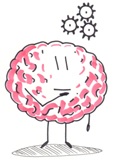Jelena King PhD, Elena Ballantyne PsyD, Heather McNeely PhD

Image credit: Stuart Miles/freedigitalphotos.net

You are walking down a familiar street. You see someone you know on the opposite side. You smile and wave.
The person does not respond in any way. They walk past without any sign of acknowledging you.
Write down any thoughts that are going through your mind in this scenario:

Image credit: Headspace

How can two people have different thoughts about the same situation?
Sometimes we can be in the same situation, but have different thoughts about it at different times. Emotions and experiences can shape our thoughts – so, thoughts are personal interpretations of a situation. Thoughts are not necessarily facts. However, many of us tend to live and react as if our thoughts are facts. If these thoughts are negative (as they often can be when we are under stress) they can bias our viewpoints and lead to distorted interpretations that over time can decrease resilience and increase vulnerability to stress, and especially if we are not taking care of ourselves, not eating or sleeping properly, or find ourselves over-burdened with work.
What we tell ourselves about a situation can influence how we feel, how we interact with others, and what we might or might not do. For many of us, these thoughts are often automatic and not always consciously apparent until we notice experiencing strong emotion that is not congruent with the situation – “emotional overreactions”. It is likely that in these instances we are falling into “thinking traps” or patterns of thinking that correspond to beliefs, assumptions, or expectations we have about ourselves, others, and how certain situations should unfold. These core beliefs arise from previous experiences and interpersonal interactions (both negative and positive) and are continually shaped and modified throughout our lifetime. For some of us, these can remain fixed and inflexible so that depending on the context we find ourselves in, can either help or hinder us. Examples of fixed beliefs in medical school might be:
“I should succeed at everything I put my mind to”
“Failure is a sign of weakness”
“If something goes wrong, it is because of incompetence”
“Mistakes are not alright and should be avoided”
If nothing goes wrong (no failure, no mistakes, you are achieving success), these core beliefs can become formed, maintained and strengthened to become more permanent and fixed. These beliefs can also motivate and drive you to attain further success and achieve your goals. Ultimately, however, we all face disappointment, loss, or adversity through unexpected events. If our core beliefs or thinking traps are incongruent with the challenges unfolding and we are thus “psychologically inflexible”, managing the unexpected flexibly, challenging our thinking, and responding with resilience becomes difficult. We can often become stuck, then stress amplifies, and moves us further away from constructive solutions and we become more vulnerable and less resilient.
 Psychological flexibility refers to the ability to adapt to fluctuating demands, shift and balance perspectives and consider alternative courses of action when faced with difficult situations. Being psychologically flexible builds resilience and confers greater mental and physical wellbeing during times of stress. In order to be psychologically flexible when faced with unexpected circumstances, we need to have full awareness of the present moment. This requires us to take time to STOP and notice what is happening and what we are thinking when we are experiencing strong emotions. In these instances, it can be helpful to give them a label. You might think of it like sorting through your mail – some may be notices you need to respond to (e.g., bills), but much of what you receive may be just junk (unhelpful thoughts or thinking traps).
Psychological flexibility refers to the ability to adapt to fluctuating demands, shift and balance perspectives and consider alternative courses of action when faced with difficult situations. Being psychologically flexible builds resilience and confers greater mental and physical wellbeing during times of stress. In order to be psychologically flexible when faced with unexpected circumstances, we need to have full awareness of the present moment. This requires us to take time to STOP and notice what is happening and what we are thinking when we are experiencing strong emotions. In these instances, it can be helpful to give them a label. You might think of it like sorting through your mail – some may be notices you need to respond to (e.g., bills), but much of what you receive may be just junk (unhelpful thoughts or thinking traps).
It is important to recognize that some types of thoughts are helpful, some can be unhelpful, and some can be both. For example, planning thoughts can be helpful in order to organize your day. However, planning thoughts are unhelpful when you are trying to stay focused on what a patient is saying or listening to a colleague during a conversation. Other types of thoughts, such as worries, are usually always unhelpful, and often bring us into a deep spiral of negative thoughts. By giving thoughts a label, we can sort through them more quickly without getting “stuck” in them and then challenge or reframe them to be more flexible and balanced. Remember - thoughts are not facts and by labelling them we create separation or distance to more objectively determine whether they are helpful or not. This can then allow us to shift to more balanced thinking with greater ease. For example, rather than thinking “all I do is worry, I am such a worry wart, you could say, “Oh - worry thoughts are here”.
We all fall into these common thinking traps. (For more on this, see section Integrate New Lifestyles, topic Management of Cognitive Distortions.) Understanding what they are can help you label them when they arise to promote psychological flexibility that leads to healthier thinking, which can build resilience. However, it is important to highlight that healthier thinking does not always mean thinking more "positively." Healthy or balanced thinking that arises from psychological flexibility means examining the entire situation and what is happening (the positive, negative, and neutral). In some situations it is entirely normal and healthy to feel upset and have negative thoughts.


| Thinking traps | Definition |
|---|---|
| Externalization of self-worth | The development and maintenance of self-worth based almost exclusively on how the external world views you |
| Fortune telling | The process of foretelling or predicting the negative outcome of a future event or events and believing this prediction is absolutely true for you |
| Mind reading | One’s arbitrary conclusion that someone is reacting negatively, or thinking negatively toward him/her, without specific evidence to support that conclusion |
| Disqualifying the positive | The process of rejecting or discounting positive experiences, traits, or attributes |
| Black/White thinking | The tendency to view all experiences as fitting into one of two categories (e.g., positive or negative, good or bad) without the ability to place oneself, others, and experiences along a continuum |
| Minimization | The process of minimizing or discounting the importance of some event, trait, or circumstance |
| Comparison | The tendency to compare oneself whereby the outcome typically results in the conclusion that one is inferior or worse off than others |
| Magnification | The tendency to exaggerate or magnify either the positive or negative importance or consequence of some personal trait, event, or circumstance |
| Overgeneralization | The process of formulating rules or conclusions on the basis of limited experience and applying these rules across broad and unrelated situations |
| Emotional reasoning | The predominant use of an emotional state to form conclusions about oneself, others, or situations |
| Jumping to conclusions | Process of drawing a negative conclusion, in the absence of specific evidence to support that conclusion |
| Selective abstractions | The process of exclusively focusing on one negative aspect or detail of a situation, magnifying the importance of that detail, thereby casting the whole situation in a negative context |
| Should statements | The process of applying personal standards of behaviour, standards for other people, or standards about the way the world functions to all situations. Involves use of words like “should,” “ought,” and “must” |
| Personalization | The process of assuming personal causality for situations, events, and reactions of others when there is no evidence supporting that conclusion |